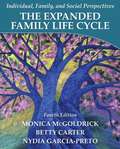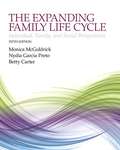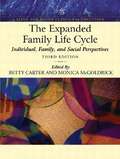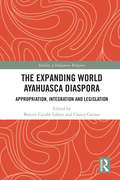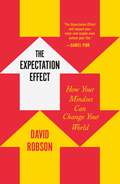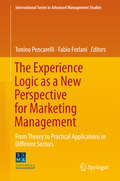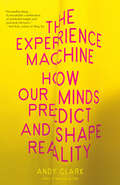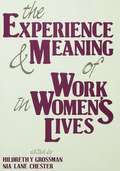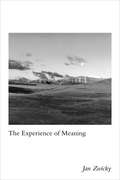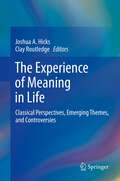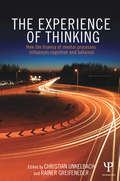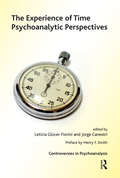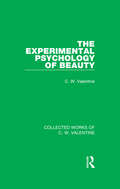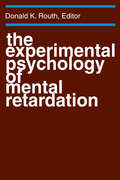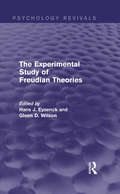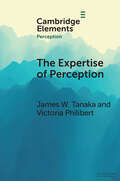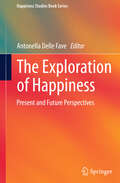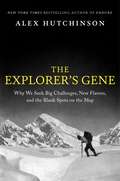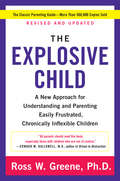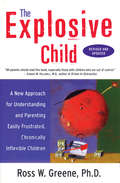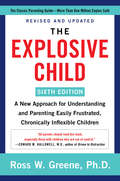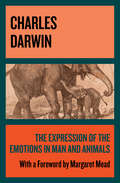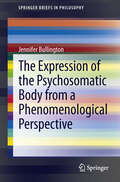- Table View
- List View
The Expanded Family Life Cycle: Individual, Family, and Social Perspectives (4th edition)
by Betty Carter Monica Mcgoldrick Nydia Garcia PretoThis classic family therapy text reflects changes in society away from orientation toward the nuclear family, toward a more diverse and inclusive definition of "family" and integrates theory and current research with clinical guidelines and cases.
The Expanded Family Life Cycle: Individual, Family, and Social Perspectives (Fifth Edition)
by Nydia A. Garcia Preto Monica McGoldrick Betty A. CarterUpdated, expanded, and more comprehensive than ever, this new Fifth Edition a classic family therapy resource, The Expanded Family Life Cycle, gives readers a solid understanding of human development and the life cycle. Featured are a groundbreaking integration of individual development within a systemic context discussion of the increasing racial, ethnic, and cultural diversity across the life cycle in the United States today; life cycle perspectives on LGBT issues, alcohol, sexuality, migration, social class, violence in the family, and assessment of “home place” as fundamental to clinical work.
The Expanded Family Life Cycle: Individual, Family, and Social Perspectives, 3rd Edition
by Betty Carter Monica McgoldrickHow does one define the concept of "family"? Is it primarily a biological link, or purely a social construction? Can it be a combination of both? Does it have to be? In this age of single parents, alternative lifestyles, and joint custody, "family" has become a fluid term which reflects a sweeping change in society -- from the rigid structure of the nuclear family to a more diverse and inclusive circle of people that one refers to as family. The authors propose a new and more comprehensive way to think about human development and the life cycle,by widening the perspective of family therapy to include diversity of family forms and lifestyles, as well as cultural diversity. Their expanded view of family includes the impact and issues at multiple levels of the human system: the individual, family households, the extended family, the community, the cultural group, and the larger society. Some issues with expanded focus include race, class, sexual orientation, gender, ethnicity, spirituality, politics, work, time, community, values, and belief systems.
The Expanding World Ayahuasca Diaspora: Appropriation, Integration and Legislation (Vitality of Indigenous Religions)
by Beatriz Caiuby Labate Clancy CavnarDuring its expansion from the Amazon jungle to Western societies, ayahuasca use has encountered different legal and cultural responses. Following on from the earlier edited collection, The Expanding World Ayahuasca Diaspora continues to explore how certain alternative global religious groups, shamanic tourism industries and recreational drug milieus grounded in the consumption of the traditionally Amazonian psychoactive drink ayahuasca embody various challenges associated with modern societies. Each contributor explores the symbolic effects of a "bureaucratization of enchantment" in religious practice, and the "sanitizing" of indigenous rituals for tourist markets. Chapters include ethnographic investigations of ritual practice, transnational religious ideology, the politics of healing and the invention of tradition. Larger questions on the commodification of ayahuasca and the categories of sacred and profane are also addressed. Exploring classic and contemporary issues in social science and the humanities, this book provides rich material on the bourgeoning expansion of ayahuasca use around the globe. As such, it will appeal to students and academics in religious studies, anthropology, sociology, psychology, cultural studies, biology, ecology, law and conservation.
The Expectation Effect: How Your Mindset Can Change Your World
by David Robson“As David Robson makes plain in this compelling book, the way we think about the world can profoundly shape how we navigate it. Based in science and packed with smart advice, The Expectation Effect will expand your mind—and maybe even extend your life.”—Daniel Pink, New York Times bestselling author of When, Drive, and To Sell Is HumanA journey through the cutting-edge science of how our mindset shapes every facet of our lives, revealing how your brain holds the keys to unlocking a better youWhat you believe can make it so.You’ve heard of the placebo effect and how sugar pills can accelerate healing. But did you know that sham heart surgeries often work just as well as placing real stents? Or that people who think they’re particularly prone to cardiovascular disease are four times as likely to die from cardiac arrest? Such is the power and deadly importance of the expectation effect—how what we think will happen changes what does happen.Melding neuroscience with narrative, science journalist David Robson takes readers on a deep dive into the many life zones the expectation effect permeates. We see how people who believe stress is beneficial become more creative when placed under strain. We see how associating aging with wisdom can add seven plus years to your life. People say seeing is believing but, over and over, Robson proves that the converse is truer: believing is seeing.The Expectation Effect is not woo-woo. You cannot think your way into a pile of money or out of a cancer diagnosis. But just because magical thinking is nonsense doesn’t mean rational magic doesn’t exist. Pointing to accepted psychology and objective physiology, Robson gives us the practical takeaways we need to improve our fitness, productivity, intelligence, and happiness. Any reader who wants to take their fate into their own hands need only pick up this book.
The Experience Logic as a New Perspective for Marketing Management: From Theory To Practical Applications In Different Sectors (International Series in Advanced Management Studies)
by Tonino Pencarelli Fabio ForlaniThis book provides stimulating insights into the ways in which the adoption of experience logic can revitalize marketing perspectives and stimulate novel approaches to the creation and delivery of value. The first part of the book, which has a theoretical focus, reviews the international literature and offers conceptual observations on the experiential perspective. Suggestions are made on how experience logic can act as a new driver for the management of marketing processes in firms within the context of the experience economy. In the second part of the book, attention turns to the applications of experience logic in different sectors, including tourism, commerce, culture, and trade shows. Company-specific examples of benefits of the experiential approach are also explored in case studies on gift box providers, marketing of traditional local products, and the cosmetics industry. The book will be of particular interest for marketing specialists, but will additionally be of value for managers in private companies and public bodies who wish to enhance their marketing methods.
The Experience Machine: How Our Minds Predict and Shape Reality
by Andy ClarkA brilliant new theory of the mind that upends our understanding of how the brain interacts with the world&“This thoroughly readable book will convince you that the brain and the world are partners in constructing our understanding.&” —Sean Carroll, New York Times bestselling author of The Biggest Ideas in the Universe: Space, Time, and MotionFor as long as we&’ve studied human cognition, we&’ve believed that our senses give us direct access to the world. What we see is what&’s really there—or so the thinking goes. But new discoveries in neuroscience and psychology have turned this assumption on its head. What if rather than perceiving reality passively, your mind actively predicts it?Widely acclaimed philosopher and cognitive scientist Andy Clark unpacks this provocative new theory that the brain is a powerful, dynamic prediction engine, mediating our experience of both body and world. From the most mundane experiences to the most sublime, reality as we know it is the complex synthesis of sensory information and expectation. Exploring its fascinating mechanics and remarkable implications for our lives, mental health, and society, Clark nimbly illustrates how the predictive brain sculpts all human experience. Chronic pain and mental illness are shown to involve subtle malfunctions of our unconscious predictions, pointing the way towards more effective, targeted treatments. Under renewed scrutiny, the very boundary between ourselves and the outside world dissolves, showing that we are as entangled with our environments as we are with our onboard memories, thoughts, and feelings. And perception itself is revealed to be something of a controlled hallucination.Unveiling the extraordinary explanatory power of the predictive brain, The Experience Machine is a mesmerizing window onto one of the most significant developments in our understanding of the mind.
The Experience and Meaning of Work in Women's Lives
by Hildreth Y. Grossman Nia Lane ChesterIn the past, social scientists have relied predominantly on traditional models of work to understand women's experiences. These models, however, have been based on men's occupational experiences, which have been assumed to be the same for women. More recently, researchers and theorists from a variety of disciplines have begun to challenge earlier assumptions as inaccurate reflections of the realities for female workers. Newer studies have concentrated on the historical and social reasons for women's employment and career choices, including changes in economy, family, and social conditions. To provide a deeper understanding of women worker's realities by including the meaning they make of their work experiences, the editors have assembled the research of social scientists from various disciplines whose investigations focused exclusively on this subject. Their qualitative methodology provides a forum for women to voice issues, raise questions, and share self-reflections about their work experiences and the meaning they make of their work in the context of the rest of their lives. The common themes that are interwoven within the fabric of women's work experience are: the need to expand traditional definitions of what constitutes "work;" the fluid nature of boundaries between personal life and work life; the importance of the relational aspects of their work; the issues related to the uses of power at work; the role of work in the development of women's sense of self and personal identity; and the degree to which women's work experience is colored by discrimination and sexism.
The Experience of Meaning
by Jan ZwickyThe aim of this book is a recovery of interest in the experience of meaning. Jan Zwicky defends the claim that we experience meaning in the apprehension of wholes and their internal structural relations, providing examples of such insight in mathematics and physics, literature, music, and Plato's ancient theory of forms. Taken together, these essays constitute a powerful indictment of the aggressive reductionism and the reliance on calculative modes of thought that dominate our present conception of understanding. The Experience of Meaning proposes a more just epistemology, arguing for a new grammar of thought, a new way of understanding the relationship of human intelligence to the world. Engaging with philosophy, psychology, literature, fine arts, music, and environmental studies in a profound way, The Experience of Meaning will interest any reader who ponders the question of meaning and its relation to true human expression.
The Experience of Meaning in Life: Classical Perspectives, Emerging Themes, and Controversies
by Joshua A. Hicks Clay RoutledgeThis book offers an in-depth exploration of the burgeoning field of meaning in life in the psychological sciences, covering conceptual and methodological issues, core psychological mechanisms, environmental, cognitive and personality variables and more.
The Experience of Thinking: How the Fluency of Mental Processes Influences Cognition and Behaviour
by Rainer Greifeneder Christian UnkelbachWhen retrieving a quote from memory, evaluating a testimony’s truthfulness, or deciding which products to buy, people experience immediate feelings of ease or difficulty, of fluency or disfluency. Such "experiences of thinking" occur with every cognitive process, including perceiving, processing, storing, and retrieving information, and they have been the defining element of a vibrant field of scientific inquiry during the last four decades. This book brings together the latest research on how such experiences of thinking influence cognition and behavior. The chapters present recent theoretical developments and describe the effects of these influences, as well as the practical implications of this research. The book includes contributions from the leading scholars in the field and provides a comprehensive survey of this expanding area. This integrative overview will be invaluable to researchers, teachers, students, and professionals in the field of social and cognitive psychology.
The Experience of Time: Psychoanalytic Perspectives (The International Psychoanalytical Association Controversies in Psychoanalysis Series)
by Jorge Canestri Leticia Glocer Fiorini Henry F. SmithIn contemporary psychoanalysis, the concepts of time and history have become increasingly complex. It is evident that this trend offers us an opportunity to think about the intercrossing of the different temporal dimensions imbuing the subject, an inevitable aspect of the analytic process. History is time past but what is recovered is now the working through of the subject history, which carries the mark of both passing time and re-signifying time. It is precisely the notion of history that gains different dimensions when a purely deterministic analysis is disassembled. Continuities and breaks are found between subjective time and chronological time; between the inevitable decrepitude of the biological body with the passing of time and the timelessness of the unconscious; between linear, circular times and retroactive re-signification; between facts, screen memories, memory and the work of constructing history; between the times of repetition and the times of difference; between reversible and irreversible time; between the timelessness of the unconscious and the temporalities of the ego.
The Experimental Psychology of Beauty: The Experimental Psychology Of Beauty (Collected Works of C.W. Valentine)
by C.W. ValentineOriginally published in 1962, the experimental study of aesthetics was a field particularly associated with the name of C.W. Valentine, who in this book provided a critical review of research carried out since the end of the nineteenth century principally by British and American psychologists. The investigations described, many of them conducted by the author, are concerned with individual responses to what is commonly regarded as beautiful in painting, music, and poetry, an important distinction being made between the perception of objects as ‘beautiful’ as opposed to ‘pleasing’. The reactions of children and adults, and of people having different ethnic and social backgrounds, are explored in a variety of experiments dealing with specific elements, including colour, form, and balance in painting; musical intervals, discord, harmony, melody, and tempo; and rhythm, metre, imagery, and associations in classical and romantic poetry. Other experiments seek to disclose the temperamental and attitudinal factors underlying individual differences in the judgement and appreciation of specific works of art. Of particular interest are the studies of responses to modern paintings, poems and musical compositions. The findings throw light on the development of discrimination and taste and suggest the possibility of some common factor in the appreciation of these three arts. It was felt that critics as well as psychologists and aestheticians would find much to encourage reflection and to stimulate further research.
The Experimental Psychology of Mental Retardation
by Donald K. RouthThe renaissance in the field of mental retardation since World War II has been expressed both in research and in renewed practical concern for the plight of the retarded. The 1958 monograph by Masland, Sarason, and Gladwin entitled Mental Subnormality: Biological, Psychological, and Cultural Factors was one spur, if not the only one, to much of the behavioral research which emerged in the late 1950's. Similarly, the Handbook of Mental Deficiency, edited by Norman Ellis and published in 1963, gave theoretical direction to many studies in the years following its appearance.The present book and the symposium on which it is based are an attempt to continue this tradition by presenting theory-based, programmatic research in mental retardation, aimed at the scientific understanding of the psychological processes involved. The final chapter attempts to draw some of the implications of this research for the practical assessment and remediation of retardation.The experimental work reported in this book generally uses rather traditional laboratory tasks, for example, classical conditioning or discrimination learning. But the interest is in underlying processes rather than in such apparent trivia as whether the child blinks his eyelid or which of two stimulus objects he selects. Thus, this book is oriented around the psychological processes of interest, namely learning, attention, memory, language, thinking, and emotion, and concludes with a section on the relationship between these processes and the biological aspects of retardation.
The Experimental Study of Freudian Theories (Psychology Revivals)
by Hans J. Eysenck and Glenn D. WilsonOriginally published in 1973 the editors of this book collected together those studies which had been considered at the time to yield the best evidence in support of Freudian theory, and found on close examination that they failed to provide any such proof. Each paper is printed in full and is followed by a critical discussion which raises questions of statistical treatment, sufficiency of controls and alternative interpretations. The particular usefulness of this format is that it allows readers to form their own opinions while providing helpful suggestions and guidelines on how to approach experimental studies with a critical mind.
The Expertise of Perception The Expertise of Perception: How Experience Changes the Way We See the World (Elements in Perception)
by James W. Tanaka Victoria PhilibertHow does experience change the way we perceive the world? This Element explores the interaction between perception and experience by studying perceptual experts, people who specialize in recognizing objects such as birds, automobiles, dogs. It proposes perceptual expertise promotes a downward shift in object recognition where experts recognize objects in their domain of expertise at a more specific level than novices. To support this claim, it examines the recognition abilities and brain mechanisms of real-world experts. It discusses the acquisition of expertise by tracing the cognitive and neural changes that occur as a novice becomes an expert through training and experience. Next, it looks “under the hood” of expertise and examines the perceptual features that experts bring to bear to facilitate their fast, accurate, and specific recognition. The final section considers the future of human expertise as deep learning models and artificial intelligence compete with human experts in medical diagnosis.
The Exploration of Happiness
by Antonella Delle FaveThis specially selected collection of landmark work from the Journal of Happiness Studies maps the current contours, and the likely future direction, of research in a field with a fast-rising profile. This volume, which inaugurates a series aiming to explore discrete topics in happiness and wellbeing studies, features selected articles published in the Journal of Happiness Studies during its first decade, which culminated in an 'impact factor' in 2011. As the introductory work in the series, it provides readers with a vital overview of the prominent issues, problems and challenges that well-being and happiness research has had to overcome since its appearance on the scientific stage. The journal's very success evinces both the high scientific quality of the research covered, and the steadily growing interest in a subject that draws responses from a vast range of epistemological aiming points, taking in economics, sociology, psychology, philosophy, education and medicine. The series of volumes following this debut publication will represent a unique contribution to the literature in their multidisciplinary focus on particularized topics. It is reckoned that this will help strengthen cross-disciplinary synergies among authors investigating the same topic, as well as whet the appetite for happiness research among professionals and experts inhabiting a variety of academic domains. This volume addresses the theory of well-being and happiness, the different research approaches now probing their features and components, and the socio-economic and cultural issues that impact on their promotion..
The Explorer's Gene: Why We Seek Big Challenges, New Flavors, and the Blank Spots on the Map
by Alex HutchinsonNew York Times-bestselling author of Endure Alex Hutchinson returns with a fresh, provocative investigation into how exploration, uncertainty, and risk shape our behavior and help us find meaning. Off the beaten path, following unmarked trails, we are wired to explore. More than just a need to get outside, the search for the unknown is a primal urge that has shaped the history of our species and continues to mold our behavior in ways we are only beginning to understand. In fact, the latest neuroscience suggests that exploration in any form—whether it’s trying a new restaurant, changing careers, or deciding to run a marathon—is an essential ingredient of human life. Exploration, it turns out, isn’t merely a hobby—it’s our story.In this much-anticipated follow-up to his New York Times bestseller Endure, Alex Hutchinson refutes the myth that, in our fully mapped digital world, the age of exploration is dead. Instead, the itch to discover new things persists in all of us, expressed not just on the slopes of Everest but in the ways we work, play, and live. From paddling the lost rivers of the northern Canadian wilderness to the ocean-spanning voyages of the Polynesians to the search for next-generation quantum computers, The Explorer’s Gene combines riveting stories of exploration with cutting-edge insights from behavioral psychology and neuroscience, making a powerful case that our lives are better—more productive, more meaningful, and more fun—when we break our habits and chart a new path.
The Explosive Child
by Ross W. GreeneScreaming, swearing, crying, hitting, kicking, spitting, biting...these are some of the challenging behaviors we see in kids who are having difficulty meeting our expectations. These behaviors often leave parents feeling frustrated, angry, overwhelmed, and desperate for answers. In this fully revised and updated book, Dr. Ross Greene helps you understand why and when your child does these things and how to respond in ways that are nonpunitive, nonadversarial, humane, and effective.Dr. Greene describes how best to: Understand the factors that contribute to challenging episodes. Identify the specific situations in which challenging episodes are likely to occur. Reduce or eliminate challenging episodes by solving the problems that cause them. Solve problems collaboratively (rather than unilaterally) and proactively (rather than reactively). Help your child develop the skills to be more flexible, solve problems, and handle frustration more adaptively. Reduce hostility and antagonism between you and your child.With Dr. Greene's practical, expert guidance, you and your child will forge a new relationship based on communication and mutual respect.
The Explosive Child
by Ross W. GreeneWhat's an explosive child? A child who responds to routine problems with extreme frustration-crying, screaming, swearing, kicking, hitting, biting, spitting, destroying property, and worse. A child whose frequent, severe outbursts leave his or her parents feeling frustrated, scared, worried, and desperate for help. Most of these parents have tried everything-reasoning, explaining, punishing, sticker charts, therapy, medication-but to no avail. They can't figure out why their child acts the way he or she does; they wonder why the strategies that work for other kids don't work for theirs; and they don't know what to do instead. Dr. Ross Greene, a distinguished clinician and pioneer in the treatment of kids with social, emotional, and behavioral challenges, has worked with thousands of explosive children, and he has good news: these kids aren't attention-seeking, manipulative, or unmotivated, and their parents aren't passive, permissive pushovers. Rather, explosive kids are lacking some crucial skills in the domains of flexibility/adaptability, frustration tolerance, and problem solving, and they require a different approach to parenting. Throughout this compassionate, insightful, and practical book, Dr. Greene provides a new conceptual framework for understanding their difficulties, based on research in the neurosciences. He explains why traditional parenting and treatment often don't work with these children, and he describes what to do instead. Instead of relying on rewarding and punishing, Dr. Greene's Collaborative Problem Solving model promotes working with explosive children to solve the problems that precipitate explosive episodes, and teaching these kids the skills they lack.
The Explosive Child [Sixth Edition]: A New Approach for Understanding and Parenting Easily Frustrated, Chronically Inflexible Children
by Ross W Greene PhDNow in a revised and updated 6th edition, the groundbreaking, research-based approach to understanding and parenting children who frequently exhibit severe fits of temper and other challenging behaviors, from a distinguished clinician and pioneer in the field.What’s an explosive child? A child who responds to routine problems with extreme frustration—crying, screaming, swearing, kicking, hitting, biting, spitting, destroying property, and worse. A child whose frequent, severe outbursts leave his or her parents feeling frustrated, scared, worried, and desperate for help. Most of these parents have tried everything-reasoning, explaining, punishing, sticker charts, therapy, medication—but to no avail. They can’t figure out why their child acts the way he or she does; they wonder why the strategies that work for other kids don’t work for theirs; and they don’t know what to do instead.Dr. Ross Greene, a distinguished clinician and pioneer in the treatment of kids with social, emotional, and behavioral challenges, has worked with thousands of explosive children, and he has good news: these kids aren’t attention-seeking, manipulative, or unmotivated, and their parents aren’t passive, permissive pushovers. Rather, explosive kids are lacking some crucial skills in the domains of flexibility/adaptability, frustration tolerance, and problem solving, and they require a different approach to parenting. Throughout this compassionate, insightful, and practical book, Dr. Greene provides a new conceptual framework for understanding their difficulties, based on research in the neurosciences. He explains why traditional parenting and treatment often don’t work with these children, and he describes what to do instead. Instead of relying on rewarding and punishing, Dr. Greene’s Collaborative Problem Solving model promotes working with explosive children to solve the problems that precipitate explosive episodes, and teaching these kids the skills they lack.
The Explosive Child: A New Approach for Understanding and Parenting Easily Frustrated, "Chronically Inflexible" Children
by Ross W. GreeneWhat's an explosive child? A child who responds to routine problems with extreme frustration-crying, screaming, swearing, kicking, hitting, biting, spitting, destroying property, and worse. A child whose frequent, severe outbursts leave his or her parents feeling frustrated, scared, worried, and desperate for help. Most of these parents have tried everything--reasoning, explaining, punishing, sticker charts, therapy, medication-- but to no avail. They can't figure out why their child acts the way he or she does; they wonder why the strategies that work for other kids don't work for theirs; and they don't know what to do instead. Dr. Ross Greene, a distinguished clinician and pioneer in the treatment of kids with social, emotional, and behavioral challenges, has worked with thousands of explosive children, and he has good news: these kids aren't attention-seeking, manipulative, or unmotivated, and their parents aren't passive, permissive pushovers. Rather, explosive kids are lacking some crucial skills in the domains of flexibility/adaptability, frustration tolerance, and problem solving, and they require a different approach to parenting. Throughout this compassionate, insightful, and practical book, Dr. Greene provides a new conceptual framework for understanding their difficulties, based on research in the neurosciences. He explains why traditional parenting and treatment often don't work with these children, and he describes what to do instead. Instead of relying on rewarding and punishing, Dr. Greene's Collaborative Problem Solving model promotes working with explosive children to solve the problems that precipitate explosive episodes, and teaching these kids the skills they lack.
The Expression of the Emotions in Man and Animals
by Charles DarwinWith a foreword by Margaret Mead: Darwin examines genetically determined behavior, combining the science of evolution with insights into human psychology.Published in 1872, thirteen years after On the Origin of Species, The Expression of the Emotions in Man and Animals is devoted to documenting what Darwin believes is the genetically determined aspects of behavior. Together with The Descent of Man (1871), it sketches out Darwin&’s main thesis of human origins. Here he traces the animal origins of human characteristics such as pursing of the lips in concentration, tightening of the muscles around the eyes in anger and efforts of memory. Darwin&’s thesis is that if the outward signs of behavior and emotions are shown to be universal in man and similar to animals then they must be due to inherited evolutionary adaptation, not culturally acquired characteristics. Several British psychiatrists, in particular James Crichton-Browne, were consultants for the book, which forms Darwin&’s main contribution to psychology. Darwin&’s collection of detailed observations along with his acute observational abilities and pictures (a landmark in the history of illustrations within the body of the text) corroborate his thesis and form the basis of the book. The foreword by Margaret Mead is of great interest in and of itself. Her foreword, illustrated with pictures provided by her, is designed to subvert Darwin&’s chief idea. Paul Ekman, a later editor of this same work, &“wonder[s] how Darwin would have felt had he known that his book was introduced by a cultural relativist who had included in his book pictures of those most opposed to his theory.&”
The Expression of the Psychosomatic Body from a Phenomenological Perspective
by Jennifer BullingtonThis book is a contribution to the understanding of psychosomatic health problems. Inspired by the work of the French phenomenologist Maurice Merleau-Ponty, a phenomenological theory of psychosomatics is worked out as an alternative to traditional, biomedical thinking. The patient who presents somatic symptoms with no clearly discernible lesion or dysfunction presents a problem to the traditional health care system. These symptoms are medically unexplainable, constituting an anomaly for the materialistic understanding of ill health that underlies the practice of modern medicine. The traditional biomedical model is not appropriate for understanding a number of health issues that we call "psychosomatic" and for this reason, biomedical theory and practice must be complemented by another theoretical understanding in order to adequately grasp the psychosomatic problematic. This book establishes a complementary understanding of psychosomatic ill health in terms of a non-reductionistic model allowing for the (psychosomatic) expression of the lived body. A thorough presentation of the work Merleau-Ponty is followed by the author's application of his thinking to the phenomenon of psychosomatic pathology.
